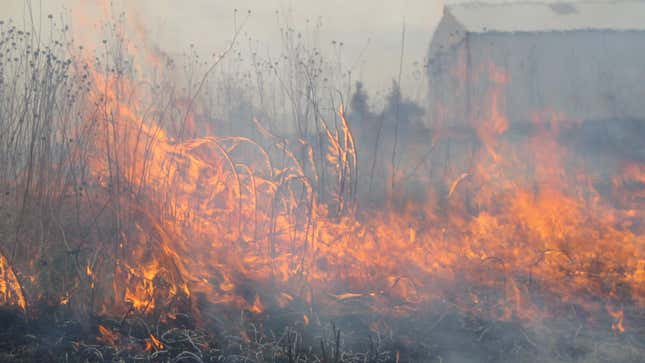
It’s a climate cliché to say the world is on fire, but it is. Right now, wildfires are burning across the Midwest in a major spring burn. The spring flames there are a warning sign of what could be an active fire season out in the coming months.
In Wisconsin, Gov. Tony Evers declared a state of emergency on Monday in response to the state’s elevated wildfire risk. According to a Sunday press release from Wisconsin’s Department of Natural Resources, the majority of the state was facing “very high fire danger” over the weekend. There have been at least 340 fires statewide since the start of 2021. Several have prompted evacuations, including the weekend’s particularly brutal brush fire in Menomonee Falls, which forced 52 households to evacuate. Some fires are still burning in the central part of the state.
It isn’t unusual for Wisconsin to see wildfires roar in springtime. The majority of wildfires in the state occur in March, April, and May, after winter snow melts. But this year, fire season got a head start because snow melted early. According to Evers’ state of emergency declaration, this year’s blazes have already burned more than 1,500 acres, which is nearly as much as the 1,630 total acres that got scorched throughout the entire season in 2020.
Things are far from over. The National Weather Service’s spring outlook indicates warmer and dryer than normal conditions are likely, which create tinderbox-like conditions for brush fires. State authorities have called on Wisconsin residents to avoid lighting campfires or other blazes outside, properly dispose of cigarettes, and “use caution with off-road vehicles or equipment that can create a spark.”
It’s not just Wisconsin that’s seeing elevated fire risk. Blazes are also spreading across North Dakota. They’re calming down now South Dakota, but last week, they were so bad that officials closed Mount Rushmore. And 500 wildfires have also burned a total of 20,000 acres across the driest parts of Minnesota in the past five weeks.
The region burning isn’t just facing early spring snowmelt. According the Drought Monitor, much of the region is experiencing some form of drought ranging from abnormally dry conditions in Wisconsin to extreme drought in the Dakotas.The The latest Drought Monitor report, released last month, shows that each of these states are experiencing drier-than-average conditions this spring.
“When it came to what the monitor was saying for the Midwest region ... there was a decent amount of precipitation across the Corn Belt,” Bryan Peake, a climatologist with the Midwest Regional Climate Center, said. That explains why Illinois, Iowa, and Missouri were safe from fires. “But there wasn’t too much in the northern and getting into the upper Midwest.”
Research shows the state has heated up by more than 2 degrees Fahrenheit (1.1 degrees Celsius) since 1950. Winter is also the fastest-warming season for the state as well as the Dakotas, creating increasing inhospitable conditions for snowpack to linger.
Natural climate shifts can also play a role influencing whether the Midwest faces fire—or floods, as it did in 2019. Peake noted the Arctic Oscillation and North Atlantic Oscillation, two climate phenomena that can affect the contortions in the jet stream, have the most marked effect on the region’s climate.
“They can be more or less wavy, have more or less up and down pattern, and that can cause the jet stream to have changes which has a big impact on on weather in the Midwest,” said Peake. “Any sort of change in the waviness and the patterns of the jet stream can lead to more extremes, whether it’s extreme cold or more extreme warmth, or more or less precipitation. ... We’ve seen a lot of those extremes in the past 10 or 15 years.”
Some studies have indicated the increasing waviness in the jet stream could be tied to the climate crisis, particularly shrinking Arctic sea ice and its influence on the atmosphere. Research is ongoing in the area, though.
Dan Vimont, director of the Nelson Institute Center for Climactic Research at the University of Wisconsin at Madison, said that while climate change clearly played a huge role in sparking recent devastating wildfires in California and Australia, the same can’t be said about the Wisconsin wildfires.
“If anything, climate change is likely to cause more rain and wet conditions in Wisconsin during winter and spring, which we have certainly seen over the last decade,” he wrote in an email. “I expect this is just natural climate variability.”
South Dakota has seen more dry spring seasons recently, particularly in 2017, 2018, and 2020. (There have been exceptions—2019 was South Dakota’s wettest year on record.)
“There’s been widespread drought in the western half half of the contiguous U.S., and it’s been persistent for several years now,” Ed Hopkins, Wisconsin’s assistant state climatologist, said.
The fires in the Midwest are a worrisome omen of what’s to come for the western U.S. later this year. Parts of Nevada, Utah, Colorado, Texas, New Mexico, Arizona, and California are also facing exception drought, the worst Drought Monitor category. And fire managers are preparing for a rough season ahead with elevated fire risk across the Southwest for the next three months before the bullseye shifts to California.